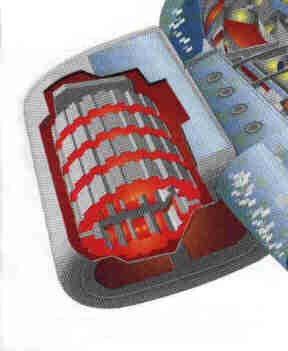So What's Next?

As I mentioned before, these extra dimensions, sub-nuclear forces, and more exotic forms of matter will be encountered as we build larger and more powerful accelerators which use powerful proton (or anti-proton) beams to bombard heavy metals and other materials, or go head-to-head with other particle beams. This is how researchers force elementary particles to undergo change. What we discover is dependent on how large and powerful our accelerators are, which is a technological and funding restraint. Acquiring enough antimatter to do experiments with is another problem (there just isn�t enough of it to go around), but as our accelerators become more powerful we are able to produce more antimatter. Our current Periodic Table of the Elements shows only 109 known elements, but that may not be the end of the story. Although the nuclei of elements 108 and 109 are so massive that they cannot stick together (unstable) and hence decay into lesser forms of matter, there may be �islands� of stability with higher elements. What properties would these exotic forms of matter have? The interaction of the �strong nuclear� force (the force that keeps a nucleus together) is already behaving in a special way if these higher elements are stable, so bombarding these elements with our accelerator beams will doubtless have special results. Perhaps the long awaited supergravity field? Such a field, if it can be generated, can be accessed and amplified over a large area, much like a radio amplifies electromagnetic fields for broadcast. Such a supergravity field would allow us to time travel, make ourselves invisible, shield us from radiation and other energies, and make distances shorter, all of which happens in areas of space where there is intense "regular" gravitation when space is "wapred" (like around a star, or in the extreme case inside the event horizon of a black hole).
This is a picture of the port "warp coil" from Star Trek's U.S.S. Defiant (see a picture of the ship in my Star Trek Photo Gallery).

The coils are made of a fictional material called "verterium cortenide", which we can surmise must be very dense because "verterium" must be a higher element than element 109 if it does not appear on our Periodic table of the Elements. Anyways, a beam of anti-protons from the Defiant's anti-matter storage bottles (its fuel source) successively strikes each warp coil, producing a moving "warp field". Actually, the beam is a proton-antiproton mixture that is "tuned" by the "dilithium crystals" in the "warp core" which is in the engineering bay of the ship. The "dilithium crystals" keep the proton-antiproton mixture from annihilating each other until the beam strikes the warp coils. The bit with the "dilithium crystals" makes things a bit more interesting, but the basic idea is: tremendous energy striking this exotic matter makes a warp field.
Below is a picture of a "warp coil" from one of the two "warp engines" of the new U.S.S. Enterprise. It works the same way as the Defiant's engine, but with a lot more coils.

They say that truth is stranger than fiction. I personally am not satisfied with the singular function of Star Trek's warp engines, because if you could generate such fields, many more things would be possbile as I mentioned before, like time travel, invisibility, and shielding, all from this one device.
Dr. Stephen Hawking has said that he is "working on" warp drive. It's about time, don't you think?
May the Force be with you.Go back to Eleven Dimensions
Go back to Homepage Index

� 1998 [email protected]

This page hosted by  Get your own Free Home Page
Get your own Free Home Page
![]()

